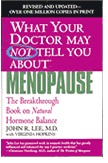
A Gallup poll sponsored by the National Osteoporosis Foundation found that:
Should You Take Hormone Replacement Therapy to Prevent Osteoporosis or Osteopenia?
There is a misperception that osteoporosis or osteopenia begins at menopause. In reality, bone mass begins declining in most women in their mid-thirties, accelerates for 3-5 years around the time of menopause, and then continues to decline at the rate of about 1-1.5% per year. Because bone loss accelerates at menopause, and because estrogen levels decline at menopause, conventional medicine has adopted the belief that osteoporosis is an estrogen deficiency disease that can be cured with estrogen replacement therapy. This is only partly true. The missing piece of this puzzle is diet and lifestyle, plus the bone-building hormone progesterone, which drops much more precipitously at menopause than estrogen does. (When I refer to progesterone, I mean the natural hormone, not the synthetic progestins. Read my books for details on the differences.)
There is no question that estrogen can slow bone loss around the time of menopause, but the scientific evidence is very clear that after 5-6 years, bone loss continues at the same rate, with or without estrogen. A very large study published in the New England Journal of Medicine in 1995, studying risk factors for hip fractures in white women, which followed over 9500 women for eight years, found no benefit in estrogen supplementation in women over the age of 65. If estrogen was the only known treatment for osteoporosis, it might be worth taking it to get the small saving in bone density, despite all the risks and side effects. But since it's clear that progesterone, combined with proper diet and exercise, steadily increases bone density regardless of age, there are very few women who should ever need to take estrogen for osteoporosis or osteopenia.
Women who need estrogen tend to be those who are petite, slim and small-boned. After menopause, a woman s fat cells make estrogen, but a slim woman may not be making enough to keep up with bone loss. Those women may need a very low dose of estradiol. You can read the November 98 back issue of the John R. Lee M.D. Medical Letter, for a detaled article on how to decide whether you need estrogen.
There are a number of pharmaceutical drugs being used to treat osteoporosis and osteopenia, none of which work very well, and all of which have unpleasant side effects. One of the best known is fosamax, a biphosphonate drug that can slow bone loss. Unfortunately, the old bone which is saved by using fosamax is eventually structurally unsound, and after three or four years it has no benefit, and I suspect it tends to increase the rate of hip fracture after about five years. For awhile fluoride was being touted as an osteoporosis drug, but like fosamax, it only slows bone loss temporarily, and the long term consequence is an increased rate of hip fracture due to structurally unsound bone. Another conventional medicine osteoporosis drug is called Calcitonin-salmon (Calcimar). This is a hormone made by the thyroid gland that can temporarily slow bone loss. Again, the long term side effects are not well known, and its effectiveness diminishes rapidly after a few years.
Progesterone and Osteoporosis
One of the most important factors in osteoporosis and osteopenia is a lack of progesterone, which causes a decrease in new bone formation. Years of clinical experience giving women progesterone showed me that using a natural progesterone cream will actively increase bone mass and density and can reverse osteoporosis. These patients consistently show as much as a 29 percent increase in bone mineral density in three years or less of progesterone therapy. After treating hundreds of patients with osteoporosis over a period of 15 years, I found that those women with the lowest bone densities experienced the greatest relative improvement, and those who had good bone density to begin with, maintained their strong bones.
Postmenopausal women using a transdermal (on the skin) progesterone cream or oil should use the equivalent of 15-20 mg daily for three weeks out of the month, with a week off each month to maintain the sensitivity of the progesterone receptors. You can read the book What Your Doctor May Not Tell You About Menopause for details on how to use progesterone cream.
Exercise for Strong Bones: Use 'Em Or Lose 'Em
Lack of exercise is one of the primary causes of osteoporosis and osteopenia. Using your bones keeps them strong and healthy. Weight-bearing exercise is the only thing besides progesterone found to actually increase bone density in older women. By weight-bearing I mean exercise that uses your bones. Brisk walking counts as weight-bearing exercise, but add some hand-held weights and it's even better. Pushing a vacuum cleaner or lawn mower, gardening, dancing, and aerobic exercise also qualify.
Your exercise plan should include a minimum of 20 minutes of weight bearing exercise three to four times a week. An hour is even better. In contrast to women who exercise, those who don't continue to lose bone, regardless of what else they are doing. Studies of elderly people who fall and break a bone show that these people had poor flexibility, poor leg strength, instability when first standing, and difficulty getting up and down in a chair. Exercise can help increase flexibility, strength, and coordination. A weight lifting program of just half an hour three to four times a week can significantly improve bone density. You don't need to go to the gym to do a weight lifting program. You can lift a can of peas or a small carton of milk. Women with advanced osteoporosis should work with a physical therapist to create a safe, effective program to reduce the risk of fracture. The Asian movement exercises such as yoga, tai chi and chi kung can also be excellent for improving strength, flexibility and coordination.

|
What Your Doctor May Not Tell You About Menopause |